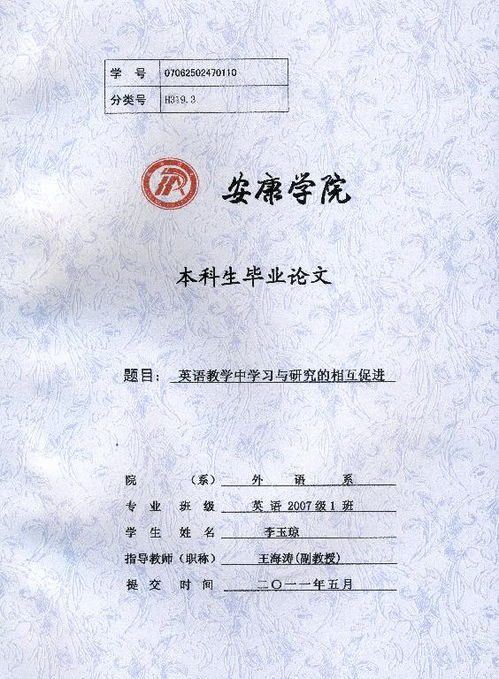毕业论文范文英语专业
毕业论文范文英语专业
Abstract: Classroom teaching is the main way for students to learn English. But in senior high school, a lots of probelms still exsit in the English teaching especially in the teaching of reading and writing. In this paper, the importance and methods of reading and writing will be further discussed. Key words: reading writing techniques
Introduction: Classes should be learner-centered, with meaningful, functional activities, often, classes begin by finding out what the students don’t know. These classes operate on the assumption that there is a great deal of information that students lack and that the teacher and textbooks will impact that information to the students. Teachers who hold this assumption view students as plants waiting passively to be fed and watered. But I think the students should be regarded as explorers, active learners who bring a great deal to the learning process and at the same time, draw from their environment as they develop new understandings. The basic principle will be used in the teaching of reading and writing.
Section One------ How to teach reading
I. Why teach reading
There are many reasons why getting students to read English texts is an important part of the teacher’s job. In the first place, many of them want to be able to read texts in English either for their careers, for study purposes or simply for pleasure. Anything we can do to make reading easier for them must be a good idea.
Reading texts provide good models for English writing, provide opportunities to study language vocabulary, grammar, punctuation, and the way to construct sentences, paragraphs and texts. Lastly, good reading texts can introduce interesting topics, stimulate discussion, excite imaginative responses and be the springboard for well-rounded, fascinating lessons.
The last but not the least, students must read widely because only a fraction of knowledge about the world can come from other experiences in their short lives.
II. What kind of reading should students do?
When the teachers give reading class to students, they should notice a balance----a balance to be struck between real English on the one hand and the students’ capabilities and interests on the other. There is some authentic written material which beginner students can understand to some degree: menus, timetables, signs and basic instructions, for example, and, where appropriate, teachers can use these. But for longer prose, teachers can offer their students texts, which, while being like English, are nevertheless written or adapted especially for their level. Anyway, the materials to be read should be interesting and meaningful. Teachers should become better acquainted with books written specially for teenagers and dealing with their problems.
III. What are the principles behind the teaching of reading?
i) Permit Students To Read
No one has learned to swim by practicing the skills of backstrokes, flutter kicks or treading water while staying on the edge of the swimming pool. Yet, in the teaching of reading teachers often do just that. Rather than let the students into “the water”, teachers keep them in skills books learning rules about letters, syllables or definitions of words rather than letting them into the book itself, permitting them to be immersed in the language which comes from the authors as the readers try to reconstruct the written message.
ii) Encourage students to respond to the content of a reading text, not just to the language
Of course, it is important to study reading texts for the way they use language, how many paragraphs they contain and how many times they use relative clauses. But the meaning, the message of the text, is much more important. Teachers should help students understand that the main reason to read is for them. They have to have their own purpose to read and reading must make sense, they have to find ways of doing something about it. They should be encouraged either to reread or to continue reading to gain meaning. But they must realize that the meaning is not in the teacher, but in the interaction between the reader and author. Students should be encouraged to ask themselves repeatedly, “Does this make sense to me?” Students should be encouraged to reject and to be intolerant of reading materials that do not make sense.
iii) Encourage students to guess or predict
Readers’ guesses or predictions are based on the cumulative information and syntactic structure they have been learning as they have been reading. Therefore, their guesses are more often than not appropriate to the materials. Students have to realize that risk taking in reading is appropriate; that using context to decide what words mean is a proficient reading strategy and that they have the language sense to make appropriate guesses which can fit both the grammatical and semantic sense of what they are reading.
iv) Match the task to the topic
Once a decision has been taken about what kind of reading text the students are going to read, teachers need to choose good reading tasks—the right kind of questions and useful puzzles, etc. Asking boring and inappropriate questions can undermine the most interesting text; the most commonplace passage can be made really exciting with imaginative and challenging tasks. Working in groups, the English teacher and students take turns asking each other questions following the reading. The teacher may ask, “ What is the significance of the character’s age?” These questions require inferences based on details from the reading text.
Section Two------How to teach writing (Developing correctness in students’ writing)
“Students learn to write by writing, and they learn to write correctly by writing, revising, and proofreading their own work”---with some help or direction from the teacher when it is necessary. They do not learn to write correctly by studying about writing or doing isolated workbook exercises unrelated to their own writing. So, the most important technique a teacher can use to guide students toward grammatically correct writing is to let them write, let them write things related to their own experiences. There is no limit to the kinds of text the teacher can ask students to write. Teachers’ decisions, though, should based on how much language the students know, what their interests are.
“Do I read a paper and ignore all punctuation, what good is that for students
We spend hours at night with papers---I’m not sure the students get as much from it as the time I spend on it.”
These comments by senior high school English teachers discussing the process of marking student papers reflect the dissatisfaction and frustration of many teachers over the problem of dealing with the errors in student writing-----the obvious mistakes in spelling, punctuation----Traditionally, teachers have worked to correct errors in two ways: by teaching grammatically correctness through exercise in grammar texts; by pointing out all errors when making student papers.
Most students find it very dispiriting if they get a piece of written work back and it is covered in red ink, underlings and crossing-out. It is a powerful visual statement of the fact that their written English is terrible. Of course, some pieces of written work are completely full of mistakes, but even in these cases, the teacher has to achieve a balance between being accurate and truthful on the one hand and treating students sensitively and sympathetically on the other.
Some techniques can be used in dealing with the errors in student papers:
i) Selectivity
Rather than engage in intensive error-correction when responding to student writing, teachers are encouraged to adopt a more moderate approach to error. If the teacher over-corrects the students’ mistakes, the students would be likely to focus on errors instead of ideas. Students are more likely to grow as writers when the teacher’s primary purpose in reading student papers is to respond to content. However, if attention to content and correctness are combined when making papers, it is more helpful to select one or two kinds of errors the individual student is making than to point out every error in the paper. The teacher can identify a selected error, show an example or two on the student paper, and either explain the correct form or direct the student to a handbook for further explanation. It is always worth writing a comment at the end of a piece of written work -----anything from “Well done” to “This is a good story, but you must look again at your use of past tenses---see X grammar book page xx.”
ii) Error-analysis
Another method for working with student error, one that can be especially fruitful for teachers, is to approach it from an analytic perspective. Teachers, as error-analyst, look for patterns in the errors of an individual student, tries to discover how the mistake arrived at the mistakes by analyzing the error (Lack of knowledge about a certain grammatical point; A careless one or a mis-learned rule?), and plans strategies accordingly.
iii) Publish Student Writing
The final basic strategy is publishing. Students need a reason for laboring over a draft until it is perfect; the urge to see oneself in print can be a powerful drive toward revision and proofreading.
Conclusion: As teachers to the students who are in senior high school, they should learn to turn students’ hard work toward supporting the language strengths students already have, proving students with a feeling of success, finding materials and planning classroom experiences will turn students on to reading and writing, the reading and writing will develop with much greater ease than it does at the present time.

英语专业大学毕业论文范文
英语专业大学毕业论文范文
论文题目:浅BEC考试对高职英语测试设计的借鉴作用
摘要:本文根据BEC中级考试的交际性语言测试特征,并结合高职英语测试设计的目标和重点,从考试内容和题型设计两个方面提出了对高职英语测试的参考建议。
关键词:BEC考试;交际性测试;高职英语测试
一、BEC及其交际性测试特征
(一)BEC考试概况
BEC是剑桥大学考试中心为非英语国家人员的国际商务活动需要而专门设计的一项测试,尤其注重语言的交际功能。其目的是考查应试者在具体的商务环境中实际应用英语的能力,考查其能否正确的理解、处理工作中的问题。BEC考试内容以“需求分析”为理论基础,测试学生在实际交际活动中完成任务的能力。考试根据语言学习中听、说、读、写这四项基本能力,设计了阅读、写作、听力及口语四部分,针对不同语言水平的受试者,BEC分为初级、中级和高级三个等级。
(二)交际性测试特征
早期的语言测试受结构主义语言学影响,认为语言是由语音、词汇、语法等语言系统构成的元素,多数采用题型有多项选择、语法填空等分离性的测试方式,此类测试虽能保证语言测试的可信度,但却忽略了语言的整体性和内部各元素间的相互作用。20世纪80年代后期,交际性语言测试发展成为一股强大的理论潮流,冲击了早期的语言测试模型。测试研究人员开始注重考查受试者在一定语境中运用语言进行有效交际的能力。在1990年,美国当代著名应用语言学家Lyle.F.Bachman提出交际语言能力模型(Communicativelanguage ability model)理论,认为交际语言能力是指语言知识能力与语言使用场景的特征结合起来,创造并解释其意义的一种能力。交际性测试相对于传统测试具有以下几个明显特点:(1)重视需求分析。(2)具有真实性,认为测试应该从交际的真实性(real-life authenticity)和情景的真实性(interactionalauthenticity)两个方面来定论。(3)该测试强调语境与情景的重要作用。(4)交际性测试在语言篇的基础上将听说读写四项技能和考点做出了综合处理,不仅限于传统分离性的测试方法。(5)由于交际性测试衡量的是应试者的表现可否能满足现实生活交际需求,所以它按照标准参照性(criterion-referenced)尺度来评定应试者的能力,重视主观性评判。
(三)BEC交际性测试特征的体现
BEC测试在很大程度上体现了交际性测试中所涵盖的内容、交际情景和功能。剑桥大学地方考试委员会曾对非英语国家人员进行商务活动的种种需求进行大量调查研究,根据总结的目标行为(work-related“can-do”statement)制定了一套考试大纲,考查应试者的英语语言能力。BEC测试的规范内容充分体现了交际性测试的特征,内容规范主要涵盖测试的内容、方法、目的、用途、时间长度、试卷构成及评分标准等多方面。下文以《剑桥BEC真题集(中级)》(2011)为例,对其内容和题型进行分析。
1.BEC中级考试的内容分析。BEC考试的内容是以实际工作中的商务活动为载体,评估应试者的语言能力。通过阅读、写作、听力及口语四种方式,还原商务活动中的实际情景,来确保测试真实性。阅读材料均来自真实素材,涵盖面广,主要有公司简介、工作岗位责任说明、事实报告及商务礼仪等。阅读部分体现的情景特征与应试者在职场中目标语应用的情景特征高度一致。BEC中级听力部分的情景真实性,主要是体现在听力题材来自于真实的商务对话,保留了日常口语交际中停顿及会话中的自我等特点,而不是简单地录音和阅读材料。情景主要是商务活动中常遇到的问题,如产品质量投诉、会议的组织安排及协调解决工作中的问题等。写作部分中,第一部分短文写作和第二部分商务信函或报告,都明确设置特定情景,如考生作为一名总经理秘书,如何拟定会议通知,并发布给全体职员。写作情景的设置使写作任务更有目的性和交互性,更能考查受试者的语言能力。其次,真实情景的设置,限制了受试者的写作内容,有利于制定统一的评分标准,减少了主观性对评卷的影响,增加了测试的效度。在口语测试的三部分中,第一部分要求应试者以其真实身份回答面试官的问题,情景真实自然,互动性较强,可称为热身练习;第二部分要求受试者就商业话题进行简要口头陈述;第三部分为受试者提供了具体情景,明确规定交际任务和目标。
2.BEC中级考试的题型分析。BEC中级试题设计新颖,题型多样化,重视主客观题的比例,并关注测试的信度和效度。阅读题型虽然以客观题为主,但也搭配有多项选择题与多项选择完形填空题等多种题型,从不同维度考查应试者的阅读能力。听力部分题型包括填空、多选项搭配和多项选择等主客观题,相互结合,相得益彰。写作和口语部分的题型设计主要测试受试者在特定情景下的语言输出能力,大部分的任务模式设计来源于现实的商务写作,如记录电话录音、改正商务信件中的错误表达等,体现了测试的交际真实性。阅读材料的'五个部分从不同层面考查了受试者的词汇、句法、篇章结构和阅读技能;听力部分考查了受试者的听记技能、对篇章和细节的理解、语域等语用知识的把握等。BEC中级考试是以篇章为基础设计的,为受试者提供了翔实的上下文背景,同时结合自身已有的知识结构,进行合理的推断,体现了测试的交际真实性。
二、高职英语测试设计的目的及重点
语言测试是教学中不可缺少的组成部分,它们相互影响,相互补充。根据《高等职业教育英语课程教学基本要求(试行)》,高职英语课程教学应以职场交际中的实际应用为目的,培养学生英语的实际应用能力,使其能够在日常活动与未来工作活动中顺利进行基本的口头和书面交流。因此,高职英语测试的目的和重点是考查学生英语实际交际应用的能力。目前,交际教学法被普遍地应用到高职英语教学中。交际测试能更科学高效地指导学生学习,为其语言交际能力的提高起到了很大的促进作用。刘润清、韩宝成在《语言测试和他的方法》中指出,交际性语言测试的试卷设计者应在对应试者进行需求调研后,得出其目标行为,界定出应试者在未来的目标场景中应做的事情,在此基础之上制定考试大纲和内容说明等,只有这样测试才能够正确评估并指导教学。语言脱离了语境和情景就失去了具体意义,所以高职英语测试设计者要重视语境和情景的重要性,注重测试任务和文章的真实性。最有效的测试就是将语言置于原生态的真实情景语境中去考查。测试目标的真实性决定了高职英语测试必须是交际性测试,是听说读写技能的综合处理,评估标准是交际的有效性。
三、BEC的借鉴作用



